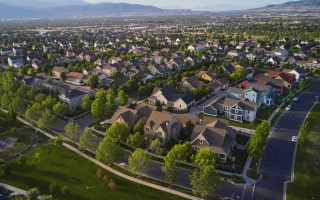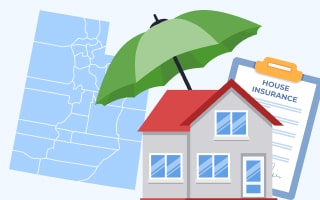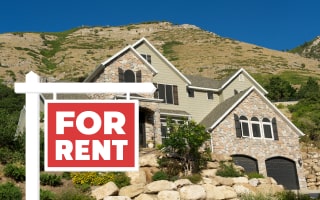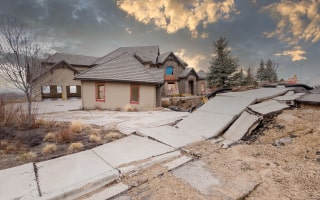Homeowners Insurance in Utah

Utah is known for its natural diversity, national parks, and even some exciting dinosaur fossils. Located smack dab in the middle of the Western part of the U.S., Utah has thick forests, arid deserts, and mountain valleys, making it prone to earthquakes, wildfires, winter storms, and flooding from lakes and rivers. All of these natural disasters can wreak havoc on property. Since 1953, Utah has had 34 federally declared disasters, and the rate of disasters per 1 million people is 9.84.
Along with wind damage, tree branches falling on houses, and wildfire damage, Utah residents also file home insurance claims for water damage due to plumbing mishaps and frozen/burst pipes, ice dams, heavy snow, and other property damage due to objects falling or debris carried by the wind, liability issues, theft, and vandalism.
Neither the federal government nor the state of Utah require property owners to carry any type of homeowners insurance. However, experts agree that anyone who owns property should have some kind of coverage. If you borrow money to buy a house in Utah, your lender will require you to keep specific limits of coverage on the home until the loan is paid off.
As of October 2024, the average rate of homeowners insurance is $2,728 a year or $227 monthly. Utah homeowners pay an average of $1,140 a year or $95 a month, which is extremely affordable and far less than the national average.
Types of Homeowner Insurance Coverage Available in Utah
Insurance providers determine the potential perils of each state and decide whether or not to offer coverage there and what types. The available types of coverage in Utah include:
-
Dwelling: Your dwelling coverage protects the structure of your home (roof, foundation, walls, plumbing, wiring, etc.) against covered perils. If your home is damaged or destroyed, dwelling insurance will pay to repair or replace it.
-
Other Structures: Other structures coverage protects your detached items like fences, pools, hot tubs, garages, and sheds. It will pay to replace them after a disaster.
-
Personal Property: Personal property coverage pays to replace your belongings should they be stolen or destroyed in a covered event.
-
Liability: If someone gets hurt on your property due to your negligence, liability insurance will pay your legal bills up to a specific limit.
-
Medical Payments: If anyone is injured on your property, medical payments insurance will pay their medical bills.
-
Additional Living Expenses (ALE): If you must leave your home after a covered disaster, ALE insurance will pay for your food, lodging, pet boarding, furniture rental, travel expenses, and more until you can return home.
Utah residents should also consider a flood policy and a possible umbrella policy to fill in any gaps in coverage.
FEMA (Federal Emergency Management Agency) manages the National Flood Insurance Program (NFIP) through a network of 50 providers across the U.S.
Since most homeowners insurance does not cover floods, this supplemental coverage can repair damage and replace items after a flood. Depending on the options you choose, it can cover the building and/or your personal belongings. This program is available to homeowners, renters, and businesses. Learn more about the program on FEMA's website.
Home Insurance and Natural Disasters
Severe weather events are becoming increasingly prevalent across the U.S. Climate change and global warming is the main factors affecting insurance rates and the home insurance industry. Over the past five years, homeowners insurance rates have risen by 34% and even as high as 60% in some high-risk areas. In Utah, rates have increased by 51.9%, which is on the very high end of rate increases.
Utah is prone to frequent earthquakes, wildfires, winter storms, and flooding, making it a medium-high-risk state. Utah averages 80-100 wildfires annually, and the average fire or lightning damage claim is $77,340. Flooding is Utah's most costly natural hazard (80% of all flood-related deaths are due to flash floods). The cost for one water or freezing damage claim is $11,650. Wind and hail claims cost an average of $11,695. From 2015 to 2019, Utah insurance carriers lost a total of $282,194,000. Utah is on the list of states with the most risk (14% of homes) of wildfire. From 1980 to 2024, Utah had 25 billion-dollar disasters.
How Can I Save on Homeowner Insurance Premiums in Utah?
Homeowners insurance rates are rising steadily in Utah, and property owners must find ways to save. The best way to understand your home insurance cost is to understand the factors that impact it most and adjust from there.
-
Location: Location is the number one factor driving insurance rates. If you live in an area prone to disastrous weather or high crime, you will pay more than somewhere safe and quiet.
-
Age of the Home: The age of your home matters quite a bit. The older the home, the more premiums you will pay.
-
Coverage Amount: The more insurance you purchase, the higher the price.
-
Size of the Home: The larger the home, the more your insurance premiums will be because it will cost more to rebuild after a disaster.
-
Condition of the Home: Homes in poor condition cost more to insure than homes in good condition.
-
Deductible: The higher your deductible, the lower your rates will be. Conversely, the lower the deductible, the higher your rates.
-
Credit History: Your credit history indicates your level of responsibility and risk. If you have poor credit, your rates will be higher than if you have a high score.
-
Claims History: If you have filed many claims in the past (even with another carrier), your rates will be much higher than if you have a clean claims history.
-
Pets: Your rates will be higher if you have certain breeds of dogs or other "perceived dangerous" pets.
In Utah, some ways to save on your homeowners insurance include:
- Fortify Your Home: Install shatterproof windows, hurricane shutters, and fire-retardant shingles to make your home more resilient against natural disasters.
- Raise Your Deductible: Raise your deductible as high as possible to lower your premiums.
- Adjust Your Coverage: Review your coverage each year and lower your coverage limits if you need to save money on your rates.
- Improve Your Credit: Work on improving your credit and then ask your insurer to adjust your rates accordingly.
- Make Your Home Safer: Install home security to make your home safer and save on home insurance.
- Bundle Policies: Bundle all your policies together with the same provider to get lower rates.
- Ask for Discounts: Ask your insurance company for any applicable discounts.
- Avoid Risks: Don't add new risks to your home and eliminate existing ones.
- Don't File Small Claims: Don't file any small claims; wait until you really need it before using your insurance.
- Home Improvements: Improve your roof, windows, and siding to make your home more weather-resistant and get lower rates.
Home Insurance Discounts in Utah
Home insurance is a policy you purchase to protect yourself financially should a disaster occur. Your home insurance company will pay to repair or replace your home if it is destroyed or damaged due to a covered peril. However, each policy has limits, and anything beyond those limits will not be covered. Most policies include dwelling coverage, liability, medical payments, personal property, and loss of use coverage.
You can easily get a policy. Find a provider you want to work with and call their 800 number or apply online through their website. You can also find a local agent to help you determine coverage levels and set a budget. You will need to pay the first year in advance, and then after that, you can pay monthly through your mortgage escrow or once a year.
The most common standard discounts offered by most carriers include:
- Senior Citizen Discount: Many firms give seniors or retirees a special discount when they reach a certain age.
- Military Discount: Most firms offer discounts on home insurance to members of the military or veterans.
- Occupational Discount: Some professions, like firefighters and teachers, earn discounts.
- Non-smoker Discount: Non-smokers offer less fire risk, and insurers discount them.
- Autopay Discount: Your carrier should offer discounts if you sign up for auto payments.
- Paperless Discount: Going paperless is good for the environment and your rates.
- Quote In Advance Discount: Get a quote well before you need it, and you might get a discount.
- Security Discount: Install a security system to avoid theft and vandalism, and your insurance provider will give you a discount.
- Fire-Safety Discount: Install fire safety equipment like sprinklers, smoke alarms, and fire extinguishers for a discount.
- New Home Discount: New homes cost less, and sometimes, you get a significant discount.
- Green Discount: Install eco-friendly materials in your home for a discount.
- Loyalty Discount: If you stay with the same company year after year, they may offer you a discount as time passes.
- Bundle Discount: Bundle multiple policies and earn a discount on your rates.
Common Rates Offer by Homeowners Insurance Firms
New homes cost a lot less to insure than older homes. In some cases, you can pay up to 40% less for a new construction home and up to 26% less for a five-year-old or younger home. In Utah, new construction homes cost an average of $894 yearly or $75 monthly for home insurance. Your actual rate will depend on your age, homeowner profile, insurance company, credit score, claims history, etc.
Top 10 Home Insurance Firms in Utah and Average New Home Savings
| Company | % savings |
|---|---|
| Nationwide | 76% |
| Amica Mutual Insurance | N/A |
| State Farm | 51% |
| Travelers | 63% |
| Allstate | 47% |
| Chubb | N/A |
| Liberty Mutual | N/A |
| American Family | 55% |
| Farmers | N/A |
| USAA | 54% |
Home Insurance and Renovations in Utah

Home renovations can completely reinvent your home, making it more usable and attractive, but they can also dramatically impact your home insurance. Some upgrades add value or risk and increase your rates. Other updates lower your risk, make your home safer, and decrease your rates. Some do not affect your rates at all because they cancel each other out.
![]() Home Renovations that Increase Rates
Home Renovations that Increase Rates
Some home renovations that increase your rates include:
- Adding a Fireplace: Nothing is nicer than a cozy fire on a cold winter's night. However, adding a fireplace will increase your fire risk and your insurance premiums.
- Hot Tub: Hot tubs, pools, fountains, and tree houses are considered "attractive nuisances" that cost extra to insure because of the added risk.
- Adding More Room: Adding square footage to your home can make it roomier for everyone, but it will also cost more to rebuild after a disaster, so your rates will increase.
![]() Home Renovations that Decrease Rates
Home Renovations that Decrease Rates
Some home renovations that decrease your rates include:
- Fire-Safety: Installing fire safety devices such as sprinklers, smoke alarms, and fire extinguishers will drastically decrease fire risk and reduce rates.
- Replace Your Plumbing: Old plumbing can leak and burst pipes, causing severe water damage. Upgrading your plumbing can eliminate these issues and help to decrease your home insurance costs.
- New Roof: Adding a new weather-resistant roof will help keep your home safer and, as a result, lower your risk of claims and your rates.
Typically, a new roof will save you money on home insurance and lower your rates unless you use luxury materials like metal. Then, they may go up or stay the same.
When you change your home, your insurance does not cover the cost. It only pays to replace or repair your home after a disaster. Other things not covered are expensive items like jewelry, furs, cars, collectibles, mold, fungus, animal damage, pest infestations, and rodents.
Discussing a potential renovation with your local agent before breaking ground is crucial. Find out how it will impact your coverage, how much more you might need after, and how it will affect your rates.
Utah Renters' Insurance

Utah renters should also have homeowners insurance to protect their assets. Renters insurance is different in that it does not include any dwelling coverage. However, it includes personal property and will pay to replace your belongings if they are destroyed in a qualifying event. Renters insurance also provides liability, medical payments, and loss of use coverage. Each policy has limits, and expensive items outside of those limits, like jewelry, furs, art, and collectibles, may not be covered. Some covered perils include fire, windstorms, theft, and vandalism.
Some of the items that renters insurance covers are:
-
Small Appliances
-
Furniture
-
Clothing
-
Bedding
-
Bath Items
-
Electronics
-
Sporting Equipment
Renters insurance is priced according to three main factors, and they are:
-
Location: Even as a renter, your location matters. If you live in the city, you will pay more than if you live in the country. If your area has many weather events, you will pay higher rates.
-
Coverage Amount: The more coverage you buy, the higher your premiums.
-
Number of Units: The more units in your building, the lower your rates.
The average Utah renter pays roughly $181 a year or $15 a month, which falls within the national average of between $15 and $20 monthly. People who live in cities where crime is higher will pay more than those who live in the suburbs or rural areas.
Condo Insurance in Utah

Utah condo owners also need homeowners insurance. Condo insurance works differently than homeowners. Condo developments have a master policy that covers the dwelling of each building. After a qualifying event (fire, windstorm, theft, vandalism), the master policy will pay to restore the building to its original condition (when it was first built). Most condo owners have updated the interior (kitchen, baths, flooring, lights, appliances, etc.), and those items will not be covered. HO-6, or condo insurance, pays to restore the condo's interior back to its most recent condition with all the updates. Condo insurance also includes personal property coverage, liability, medical payments, loss of use, and loss assessment.
Unlike renters insurance, condo insurance does have dwelling coverage, but it only applies to the interior. Also, the liability portion only works if the person is hurt inside the condo, not outside or on common grounds.
Condo insurance will pay to replace the following items as well as others:
- Furniture
- Appliances
- Flooring
- Cabinets
- Countertops
- Wiring
- Plumbing
- Interior Walls
- Light Fixtures
- Personal Belongings
Utah condo owners pay an average of $480 a year or $40 monthly for condo insurance. That is low compared to the national average of $625 yearly for $60,000 of personal property, $300,000 of liability, and a $1,000 deductible.
Some ways to save on Utah condo insurance include:
- Raise Your Deductible
- Review and Adjust Your Policy Every Year
- Improve Your Credit
- Stay Claims Free
- Shop Around for the Best Rates
- Bundle Policies
- Improve Home Security
- Install Fire Safety Devices
- Ask for Discounts
- Remain Loyal to the Same Provider
Utah Home Insurance Market
Although insurance providers in Utah saw consistent profits during the 2010s, losses have more than tripled in the past ten years. As evidenced by the tremendous rate increases, Utah's home insurance market is shifting quickly. As losses mount and claims rise, carriers may pull out of the state, slimming competition and refusing to offer coverage, limiting coverages, or canceling high-risk customers.
Utah is a high-risk state for wildfires, floods, earthquakes, and winter storm damage. As these trends continue, property owners will find it more challenging to find the coverage they need or will be unable to afford it.
No federal agency regulates the homeowners insurance industry. Instead, states create a department or agency to monitor providers and rates, investigate customer complaints, and sanction guilty firms. In Utah, that agency is the Department of Insurance, located at State Office Building Rm 3110, Salt Lake City, UT 84114.
Homeowners Insurance Guide
- Homeowners Insurance in Utah
- Types of Homeowner Insurance Coverage Available in Utah
- Home Insurance and Natural Disasters
- How Can I Save on Homeowner Insurance Premiums in Utah?
- Home Insurance Discounts in Utah
- Home Insurance and Renovations in Utah
- Utah Renters' Insurance
- Condo Insurance in Utah
- Utah Home Insurance Market
Instant Access to Utah Property Records
- Owner(s)
- Deed Records
- Loans & Liens
- Values
- Taxes
- Building Permits
- Purchase History
- Property Details
- And More!
Instant Access to Utah Property Records
- Owner(s)
- Deed Records
- Loans & Liens
- Values
- Taxes
- Building Permits
- Purchase History
- Property Details
- And More!
Homeowners Insurance Guide
- Homeowners Insurance in Utah
- Types of Homeowner Insurance Coverage Available in Utah
- Home Insurance and Natural Disasters
- How Can I Save on Homeowner Insurance Premiums in Utah?
- Home Insurance Discounts in Utah
- Home Insurance and Renovations in Utah
- Utah Renters' Insurance
- Condo Insurance in Utah
- Utah Home Insurance Market